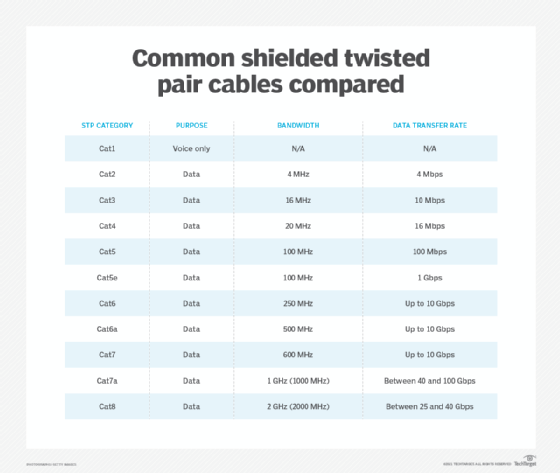shielded twisted pair (STP)
What is shielded twisted pair (STP)?
Shielded twisted pair (STP) is a special kind of copper telephone and local area network (LAN) wiring used in some business installations. It adds an outer covering or shield that functions as a ground to ordinary twisted pair wiring.
Twisted pair is the ordinary copper wire that connects many computer networks to the telephone company. To reduce cross-talk or electromagnetic induction between pairs of wires, two insulated copper wires are twisted around each other. Each signal on twisted pair requires both wires.
Unlike unshielded twisted pair (UTP), shielded twisted pair also encloses these wires in a shield and grounds them to further reduce electromagnetic and radio frequency interference. STP cables are more expensive and harder to install than UTP wiring.

How is shielded twisted pair wiring installed?
Since some telephone sets or desktop locations require multiple connections, twisted pair wiring is sometimes installed in two or more pairs -- all within a single cable. Businesses often use shielded twisted pair in their cabling system installations, while the more common kind of wire installed in homes is UTP.
Frequently, twisted pair is now installed with two pairs of cables to the home. The extra pair makes it possible to add another line -- perhaps for modem use -- when needed.
Twisted pair, be it UTP or STP, also comes with each pair uniquely color-coded when it is packaged in multiple pairs. Different uses, such as analog, digital and Ethernet, require different pair multiples. So, the color-coding makes it easier to differentiate between pairs.
Although twisted pair is often associated with home use, businesses often use a higher grade of twisted pair for horizontal wiring in LAN installations because it is less expensive than a coaxial (coax) cable. Coax and fiber optic cabling are the main alternatives to twisted pair.
In electrically noisy business environments, shielded twisted pair uses RS-449, RJ-45, RS-232 and RJ-11 connectors to maximize the reduction of interference.
How does a shielded twisted pair differ from Ethernet or telephone cable?
The telephone or Ethernet cable bought at a local hardware store to connect a phone or computer to a wall jack is not the same as unshielded or shielded twisted pair cable. It is a side-by-side wire known as silver satin.
The wall jack these cables attached to can have as many five kinds of hole arrangements or pinouts, depending on the kinds of wire the installation expects will be plugged in -- for example, digital, analog or LAN. (This is why users may sometimes find, when they carry their laptop to another location, that the wall jack connections don't match their plug when not connecting to a LAN wirelessly.)
What is the difference between STP, FTP and S/FTP, and UTP?
Let's take a quick look at the difference between shielded twisted pair cables and some twisted pair alternatives:
- STP. Shielded twisted pair cabling acts as a conducting shield by covering the four pairs of signal-carrying wires as a means to reduce electromagnetic interference. There are a variety of different types of STP cables, such as a foil twisted pair (FTP) and a shielded foil twisted pair (S/FTP).
- FTP. There are also STP cables that use a lighter, foil shield. However, note that bend radius and pulling tension must be monitored during installation to prevent these shielded cables from tearing.
- S/FTP. To avoid the possibility of tearing, there are also STP cabling systems that use a thick braided shield to make the cable sturdier. Essentially, the individual pairs of wires inside the cable are twisted and shielded to provide the best protection against cross-talk and electromagnetic interference.
- UTP. The more common kind of wire installed in a home is unshielded twisted pair. Unlike STP, FTP and S/FTP, UTP cables do not possess physical shielding to block interference. Instead, UTP relies on media filters and baluns -- a construction from "balanced to unbalanced" -- as balancing and filtering mechanisms.
In essence, the main difference between these cable types is their design. However, their purpose is the same: to provide reliable connectivity to communications hardware.
STP and data transfer rates
Shielded twisted pairs come in a variety of cable categories. The most popular in use today are Cat5e, Cat6, Cat6a and Cat7. Let's take a closer look at the different STP categories and compare their bandwidth and maximum high-speed data transfer rates.







